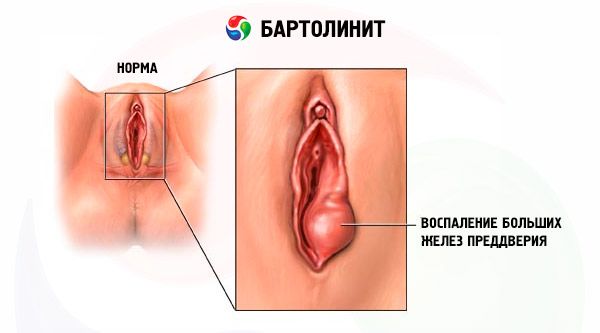Bartholinitis
Last reviewed: 23.04.2024

All iLive content is medically reviewed or fact checked to ensure as much factual accuracy as possible.
We have strict sourcing guidelines and only link to reputable media sites, academic research institutions and, whenever possible, medically peer reviewed studies. Note that the numbers in parentheses ([1], [2], etc.) are clickable links to these studies.
If you feel that any of our content is inaccurate, out-of-date, or otherwise questionable, please select it and press Ctrl + Enter.
Bartholinitis is an inflammation of the large gland of the vestibule located in the lower third of the labia majora. Inflammatory process and edema of the main excretory duct of the gland (canaliculitis) prevent the outflow of the secretion of the gland, which stagnates and becomes infected. This is a sharp false abscess. A true abscess (phlegmon) occurs when pus accumulates in the gland, melts it, and spreads the process to surrounding tissues.
Causes of the bartholinite
Bartholinitis is caused more often by non-sporeforming anaerobes, gonococcus or staphylococcus, less commonly streptococcus, E. Coli, Trichomonas, and mixed infection.
Symptoms of the bartholinite
Complaints of severe pain in the vulva: appearance of a malignant, painful formation in the labia to the size of a hen's egg that interferes with walking; temperature increase; general malaise.

A true abscess gives a clinical picture of a serious illness (severe pain, an increase and soreness of inguinal lymph nodes, an increase in body temperature to 39-40 ° C).
Where does it hurt?
Complications and consequences
False abscesses are often opened spontaneously with the emptying of the abscess. When cupping an acute process, incomplete emptying or insufficient outflow, a bartholin gland cyst (cystic formation) occurs without inflammatory signs. Bartholinitis is prone to relapse.

What do need to examine?
What tests are needed?
Differential diagnosis
The bartholin gland cyst without signs of an inflammatory process should be differentiated from the cyst of the throat. The latter is located in the middle or upper third of the labia minora and is not accompanied by inflammation.
In the presence of an inflammatory reaction - with a furuncle of the labia majora (usually located more superficially and never is as large as an abscess); the cyst of the longitudinal duct of the ovarian appendage (the cyst of the oral cavity is determined above the lower third of the labia majora, with it one can feel the stitch that goes up and down, parallel to the vaginal wall, there are no signs of inflammation of the tissues covering such a cyst); Bartholin gland cancer (typical density, tuberosity, painlessness, sometimes ulceration of the tumor).
Who to contact?
Treatment of the bartholinite
In the initial stage of acute bartholinitis, with the goal of arresting the inflammatory process, conservative treatment is prescribed (bed regimen, antibiotics or sulfonamides, an ice pack, painkillers).
When suppuration and the appearance of fluctuations revealed opening of the abscess, the introduction into the cavity of the emptied ulcer turunda with hypertonic sodium chloride solution.
Opening the abscess is preferable to make on the outer surface of the large labia to not infect the vagina. The retention cyst of the bartholin gland is subject to surgical treatment (vyluschivanu with the complete removal of the capsule) in the so-called cold period. The methods of surgical treatment include and marsupialization - the creation of a new external aperture of the outlet duct, which consists in hemming the edges of the exposed-gland wall to the edges of the cutaneous wound.

